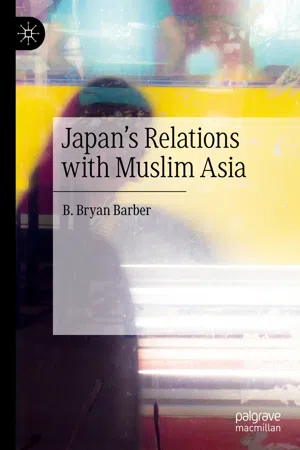In November 2006, Japanese Minister of Foreign Affairs Asō Tarō outlined an expansion of Japan’s foreign policy that he called the “Arc of Freedom and Prosperity.” Japan’s foreign policy had long stood on two key pillars: the security alliance with the United States, and relations with neighboring states in Northeast Asia. The “Arc,” however, would form a new pillar of diplomacy for Tokyo in addition to the existing two, and also become the most lucid case for values-based diplomacy elaborated by Tokyo in the postwar era. In his speech on the new pillar, Asō emphasized “‘universal values’ such as democracy, freedom, human rights, the rule of law, and the market economy” (Asō 2006). He colorfully added, “many countries are now walking down the road to ‘peace and happiness through economic prosperity and democracy.’ And, as I am fond of saying, this is exactly the road that Japan herself walked down after the war” (2006). As to Japan’s role in these developments, Asō analogized “Japan will serve as an ‘escort runner’ to support these countries that have just started into this truly never-ending marathon” (2006).
There is a double sense to this depiction of an Arc: firstly, it is a sanguine recasting of the phrase, “Arc of Instability,” frequently uttered by US diplomats in the first George W. Bush administration, but secondly, the new pillar to Japan’s foreign policy would emphasize relations with states geographically spanning across Eurasia. Asō elaborated, “there are the successfully budding democracies that line the outer rim of the Eurasian continent, forming an arc” (2006). He added, “take a look around the outer edge of Eurasia – just follow that line all the way around. This belt has seen great changes upon the end of the Cold War as the curtain was being drawn on the confrontation between East and West” (2006). Throughout the speech, Asō listed an extensive range of regions included in the Arc: Southeast Asia, the Indian subcontinent, the Middle East, Central Asia, the Caucasus, continuing on to include Turkey and all of Eastern Europe. Asō concluded his speech with the commitment, “[i]n assisting countries as they take these steps forward, Japan aims to usher in a world order that is tranquil and peaceful” (2006).
Momentarily setting aside disagreements with Asō’s assertion that “budding democracies” are forming along this Arc, the new pillar to Japan’s foreign policy is, indeed, a significant development from what was both a constrained and myopic foreign policy for a state of such global economic influence and substantial diplomatic potential. Nearly a decade later, in January 2016 Japanese Prime Minister Abe Shinzō reiterated Japan’s values-based diplomacy in a speech at the Shared Values and Democracy in Asia Symposium. Abe opened with “Asia is now poised to become a champion of democracy,” pointing out that “Asia’s democracy has a distinct mark engraved in it from ancient times, reflecting the values we have held dear for generations” (2016). Abe outlined “Asian democracy” as uniquely imparting values such as “lovingkindness,” “benevolence,” and an “utmost priority on harmony,” specifically citing the roots of these values from Asian religious traditions: Buddhism, Confucianism, and Islam (2016).
Asō’s pillar of an Arc of Freedom and Prosperity and Abe’s Asian Democracy speech illustrate a significant widening of Japan’s foreign policy which is an attempt to fortify Japan’s role in Asia. Systematically, this can be explained largely by the developments of the great powers in the region. The Western-led world order has come into question, particularly after the 2008 financial crisis and issues of domestic friction within Western states and institutions, leaving Asian states to look elsewhere, and in particular, at their own developed countries as models instead (Pehlivantürk 2016, 3). Meanwhile, Japan has been pressured by the US since the first Gulf War to take a more active role in diplomacy and collective security in Asia. Additionally, the rise of a non-democratic China encourages Japan to seek strengthening relations with states along China’s periphery, and democratic norms are a key strategy and useful narrative to do so to counterbalance a rising China. Lastly, a heightened awareness of religious violence in Asia inclines Japan to securitize—to carry out urgent measures in response to potential threats, thus politically elevating the imperativeness of the issue—for the sake of maintaining order in the Asian community through the promotion of stability and harmony—values key to Japan’s new foreign policy pillar.
Moving Forward Back?
In practice, however, is Japan’s values-based diplomacy actually working? Is Japan assisting and cultivating “budding democracies” along the Arc in its own image? If Asian democracy is based on lovingkindness, benevolence, and harmony, from an Asian épistème, does it resemble anything like Western democracy? How are conflicts in Asia being securitized by Japan, while Tokyo grapples with reconceptualizing an Asia inclusive of Dharmic, Confucian, and Muslim societies? This book argues that normativity, via values-based diplomacy , is evident in Tokyo’s foreign policy with Asian states in order to secure a leading role in Asia in light of a rising China, promote stability across the continent, and meanwhile shore up its own economic and energy security stature. A core component of this values-based diplomacy is Tokyo’s own conception of democracy, which encompasses a tripartite distinction of human rights, pacifism, and economic development.
Emphasis in this book is placed on Tokyo’s foreign policy and security policy with Muslim states along the Arc (hereafter, Muslim Asia) (see Map 1.1). Muslim Asia includes societies from 27 countries in the Middle East, Post-Soviet Asia (Central Asia and the Caucasus), South Asia, and Southeast Asia with Muslim-majority populations (see Table 1.1), and also those with significant Muslim-minority populations such as India, China, Russia, and the Philippines (see Table 1.2). Simpfendorfer describes Asia’s Muslim population “like a spine running through the region” (2...
